When people think of animals with big eyes, their minds often go straight to the land creatures like deer and owls. However, the ocean is full of fish species with equally large and impressive eyes. In fact, for fish, their eyes are just as important as they are to animals on land – if not more so. Seeing in the dark deep waters is no easy feat, as light from the surface barely travels past 3,200 feet.
Table of Contents
But at around 650 feet, enough light penetrates for some body parts to evolve and enable vision in dim light. So while we may not often think about it, fish with big eyes are a testament to the incredible adaptations that take place in the unexplored depths of the ocean.
Types of Fish With Big Eyes
Telescope Goldfish
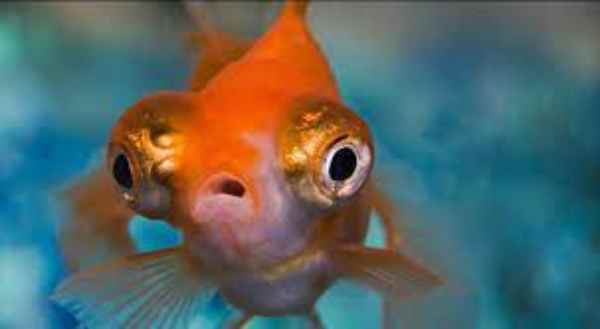
Scientific name: Carassius Auratus
Diet: Omnivore
The telescope goldfish is renowned for its remarkable feature: its large, bulging eyes that resemble telescopes. These eyes are so disproportionately large that they may appear mismatched with the rest of the fish’s body.
Selective breeding over many years has led to the creation of the telescope goldfish. However, despite their sizable eyes, these fish do not possess exceptional eyesight. In fact, their eyesight is notably poor. Nevertheless, they have developed alternative strategies for evading predators and locating their prey. They rely on discerning the silhouettes of other animals and utilize vertical movement to detect motion effectively.
Horse-eye Jack

Scientific name: Caranx Latus
Diet: Carnivore
Horse-eye jacks are a common and sought-after species in both commercial and recreational fishing. These fish possess adipose eyelids, a transparent film that covers most of their eyes, and their eyes are notably large.
Weighing around 30 pounds or more, horse-eye jacks exhibit a proportional eye size in relation to their body. In addition to their impressive eye size, these fish have good vision, which proves advantageous in locating their prey.
Horse-eye jacks are particularly popular among anglers in Panama for game fishing. When hooked, they display remarkable resilience and put up a vigorous fight, making them an ideal target for game fishing enthusiasts.
Barracuda
Scientific name: Esox Sphyraena
Diet: Carnivore
Barracuda fish may not have the exceptional eyesight of other predatory fish like the swordfish or the massive size of the telescope goldfish, but make no mistake about it, their eyes are highly effective for hunting. Moderately large in size, barracudas use their keen eyes to detect prey by the glint of light reflecting off their bodies.
However, this sensitivity can also make these fish mistake humans for prey. Divers with shiny gear, for instance, may inadvertently trigger an attack. Barracudas’ eyes are a remarkable tool for their survival, allowing them to navigate underwater environments and locate food sources with relative ease. It’s a fascinating reminder of how evolutionary adaptions are key to success in the animal kingdom.
Blue Shark
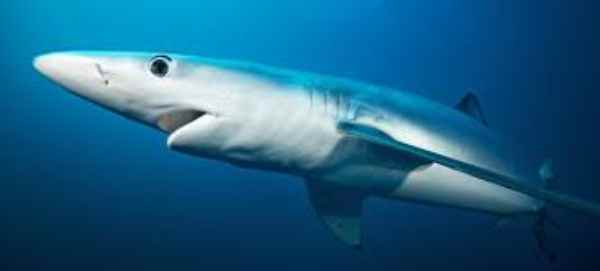
Scientific name: Prionace Glauca
Diet: Carnivore
Blue sharks are stunning creatures recognized for their notable large eyes and sleek, blue bodies. While sharks, in general, have a reputation for posing a threat to humans, it’s important to note that blue sharks’ vision is not exceptionally sharp. They can only see within a range of approximately 30 to 50 feet. Animal experts suggest that this limited vision is the primary reason why blue sharks may occasionally interact with humans, as they do not perceive them as prey.
Most incidents involving blue shark encounters with humans occur when individuals are mistaken for fish due to artificial fins or when surfers on fish-shaped surfboards are misidentified. However, if a safe distance is maintained from these sharks, the likelihood of an attack is estimated to be as low as 90 per cent. By exercising caution and keeping an appropriate distance, the potential for any harmful interaction can be significantly reduced.
Tarpon
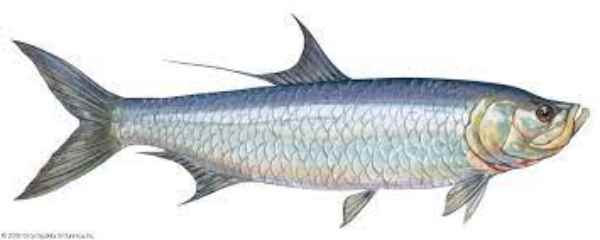
Scientific name: Megalops Atlanticus
Diet: Carnivore
As tarpons mature, their eye size undergoes changes. Adult tarpons exhibit notably large eyes. In fascinating research findings, it has been revealed that tarpons possess a colour vision that is approximately 10,000 times superior to human vision.
Tarpons possess a unique developmental trait not commonly observed in other animals. They initially grow in environments with low light conditions. However, as they transition from these depths, their retina undergoes a remarkable transformation. Cone cells, which are responsible for colour and light sensitivity, develop in their retina where previously only rod cells were present.
This development of cone cells in tarpons enhances their ability to perceive light and distinguish colours, providing significant advantages for hunting and evading predators. Furthermore, scientists believe that this extraordinary development may hold promising implications for the potential treatment of blindness in humans.
Squirrelfish

Scientific name: Holocentridae
Diet: Carnivore
The term “Squirrelfish” is commonly associated with a popular Chinese dish found in various cuisines. However, it is also the general name given to all fish belonging to the sub-family Holocentrus.
One distinguishing feature of squirrelfish is their large eyes. While some species of squirrelfish are commercially fished, others are sought after for their vibrant colours and are often kept in aquariums.
In their natural habitat, particularly within coral reefs, squirrelfish, especially those with prominent eyes, tend to gather and move in groups. They exhibit cooperative behaviour, either hunting together or defending against predators.
Coral reefs provide ample light for effective hunting, but squirrelfish are primarily nocturnal creatures, being more active during the night than during the day. This nocturnal lifestyle necessitates their large eyes, which aid them in navigating and hunting in the darkness.
Swordfish
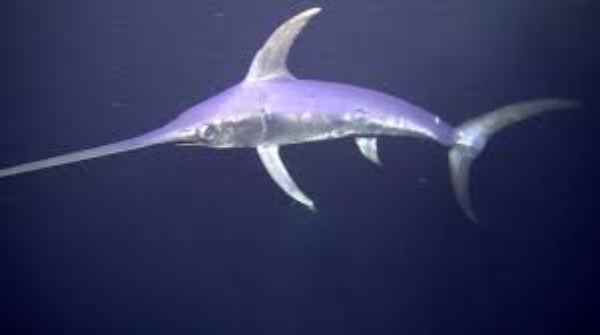
Scientific name: Xiphias Gladius
Diet: Carnivore
The swordfish is another fish species known for its notable eyes, although they are not as proportionally large as those of the telescope goldfish. Despite this, the swordfish’s big eyes serve as an advantage for a creature that primarily hunts in the depths of the ocean, where light is scarce.
What sets the swordfish’s eyes apart is not their extraordinary vision, but their ability to generate and retain heat on their own. This unique feature becomes significant when considering the concept of heat loss in water compared to air. Swordfish heat their eyes to a temperature approximately 10 to 15 degrees above the surrounding water, and they are able to sustain this heat even in the face of rapid heat loss.
Research indicates that the swordfish’s retinas are particularly adept at detecting fast movements and transmitting nerve impulses more rapidly when their eyes are warmer. The large eyes of the swordfish provide more than just enhanced visibility in darkness—they enable the fish to hunt with exceptional skill.
Bigeye Tuna
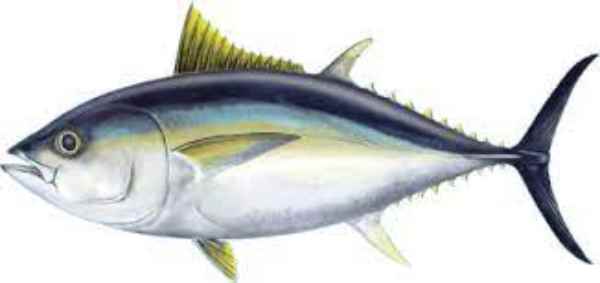
Scientific name: Thunnus Obesus
Diet: Carnivore
The bigeye tuna stands out among other fish due to its distinctive features, including its large eyes and perpetually open mouth, which gives it a surprised appearance. These fish typically swim in groups, making them a prime target for fishermen and large fishing fleets.
Bigeye tunas are highly sought after for their culinary applications, particularly in the preparation of sashimi and various other dishes. The commercial value of bigeye tuna is immense, with the fisheries associated with these fish generating billions of dollars in revenue.
Unfortunately, the demand for bigeye tuna has led to a decline in their population as they became a prized commodity in the fishing industry. However, in recent years, several regulations and laws have been implemented to address this issue and promote the recovery of the bigeye tuna population.
Bigeye Fish

Scientific name: Priacanthidae
Diet: Carnivore
Bigeye fish, as their name implies, are known for their large eyes. They share similarities with squirrelfish, displaying vibrant colours such as red and gold, along with spiny fins.
Unlike some deep-sea fish, bigeye fish inhabit depths shallower than 100 meters, so they are not completely deprived of light. However, like squirrelfish, they are primarily active at night, relying on their oversized eyes to navigate and hunt in dimly lit conditions.
There are currently 18 known species of bigeye fish, with the majority found in tropical and subtropical waters.
Rockfish

Scientific name: Sebastes
Diet: Omnivore
Rockfishes, while not having exceptionally large eyes underwater, undergo a fascinating transformation when brought to the surface. Their eyes expand, resembling two protruding lenses akin to binoculars on each side of their bodies.
This change is a result of the gas pressure in their swim bladder. When rockfishes reside deep within the ocean, the pressure of the gas inside their swim bladder matches the pressure of the surrounding water. However, when they are suddenly lifted out of the water, the swim bladder’s pressure causes their eyes to bulge outward. These relatively large eyes serve as valuable visual assets for rockfishes, considering their natural habitat at depths of up to 9,000 feet.
Spotted Ratfish
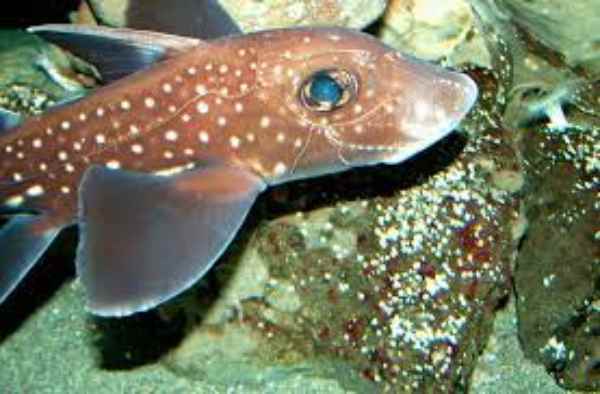
Scientific name: Hydrolagus Colliei
Diet: Carnivore
When observed from above, spotted ratfish in the sea may create the illusion of a stingray. However, upon closer inspection, their distinguishing features set them apart, particularly their prominent big eyes that stingrays lack.
The name “spotted ratfish” derives from their distinctive rat-like tail and the presence of scattered spots on their body. Their tail is sharp, resembling that of a rat, and their dorsal fin carries venom.
While not posing a significant threat to humans, the venom of spotted ratfish can be highly toxic to other marine animals, serving as a defence mechanism.
Spotted ratfish inhabit depths of around 900 meters below the sea surface, making their large eyes a valuable asset in their environment.
Pufferfish

Scientific name: Tetraodontidae
Diet: Carnivore
Pufferfish, the final contenders on our list of fish with large eyes, possess not only striking bulging eyes but also exceptional eyesight. Their acute vision plays a crucial role in their survival, enabling them to spot potential threats and potential meals from a considerable distance.
Known by various names such as blowfish, fugu, and globefish, pufferfish possess a unique ability to inflate themselves to more than twice their normal size by ingesting water. This remarkable transformation is a defence mechanism triggered when they perceive danger. However, while in this enlarged state, they swim at a significantly slower pace than usual.
These adorable aquatic creatures are widely regarded as the second most poisonous vertebrates. Just one pufferfish contains enough toxin to be lethal to approximately 30 people.
Reference:

Rahul M Suresh
Visiting the Zoo can be an exciting and educational experience for all involved. As a guide, I have the privilege of helping students and visitors alike to appreciate these animals in their natural habitat as well as introducing them to the various aspects of zoo life. I provide detailed information about the individual animals and their habitats, giving visitors an opportunity to understand each one more fully and appreciate them in a more intimate way.









